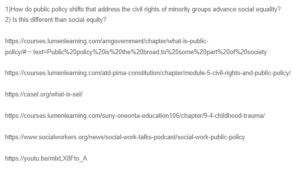Public Policy, Social Equality, and Social Equity
Public Policy Shifts Addressing the Civil Rights of Minority Groups and Social Equality
Public policy is defined as the relatively steady set of purposive legislative actions that address issues of concern to some part of society, such as the civil rights of minority groups. On the other hand, civil rights are characterized as policies that stretch out fundamental rights to groups generally subjected to segregation. The word equality does not appear in the American Constitution, and it was not until the 14th Amendment that the concept of equality was presented. The idea was to prevent states from denying residents equal protection of the law to everyone. Hence, the subject of equality has consistently been fixated on gender, race, sexuality, disability, and age discrimination.
One example of how a public policy that tends to civil rights helps advance social equality is the Voting Rights Act of 1965. In 1870, the 15th Amendment ensured African Americans the right to cast a ballot, but unfortunately, full execution didn’t happen till the 20th century. Various states in America used several strategies to bypass the 15th Amendment, including proficiency tests with grandfather clauses, white primaries, and poll taxes, all of which were ways of preventing African Americans from voting. However, after the civil rights movement, the Voting Rights Act was passed in 1965. It restricted any administration from using voting procedures that denied individuals the vote based on their race or ethnicity. With these policies, African Americans were able to vote and elect leaders who represented them.
Social Equality and Social Equity
Social equality and social equity are very different concepts. Even though both concepts advance fairness, social equality accomplishes its goal by treating everyone equally regardless of their need. On the other hand, social equity achieves its goal by treating everyone differently based on their need. An example is the use of affirmative action (government policies regarding minorities), which are policies that require special endeavors in school admissions, employment, and work promotions, all in the interest of disadvantaged groups (Kellough 2006).
References
Module 5: Civil Rights And Public Policy | State and Federal Constitution. Courses.lumenlearning.com. https://courses.lumenlearning.com/atd-pima-constitution/chapter/module-5-civil-rights-and-public-policy/.
What Is Public Policy? | American Government. Courses.lumenlearning.com. https://courses.lumenlearning.com/amgovernment/chapter/what-is-public-policy/#:~:text=Public%20policy%20is%20the%20broad,to%20some%20part%20of%20society.
Kellough, J. E. (2006). Understanding affirmative action. Politics, Discrimination, and the Search for Justice.
ORDER A PLAGIARISM-FREE PAPER HERE
We’ll write everything from scratch
Question

Public Policy, Social Equality, and Social Equity
1)How do public policy shifts that address the civil rights of minority groups advance social equality?
2) Is this different than social equity?
https://courses.lumenlearning.com/amgovernment/chapter/what-is-public-policy/#:~:text=Public%20policy%20is%20the%20broad,to%20some%20part%20of%20society
https://courses.lumenlearning.com/atd-pima-constitution/chapter/module-5-civil-rights-and-public-policy/
https://casel.org/what-is-sel/
https://www.socialworkers.org/news/social-work-talks-podcast/social-work-public-policy

